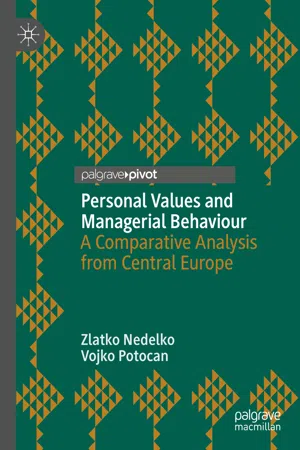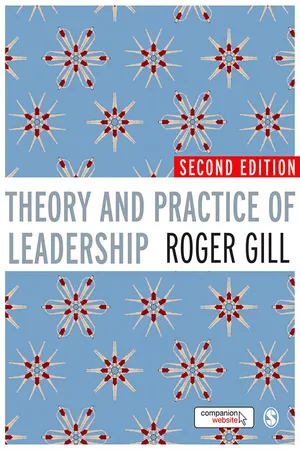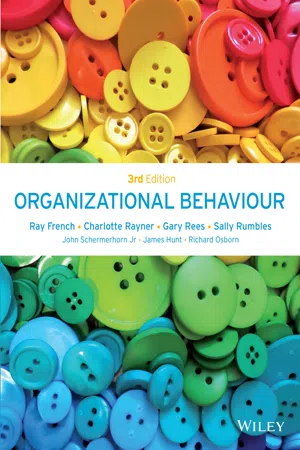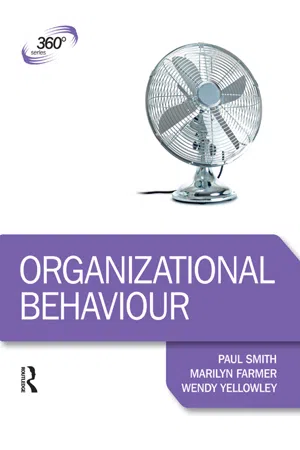Business
Personality and Values
Personality refers to the unique set of characteristics and traits that define an individual's behavior and interactions. Values are the beliefs and principles that guide a person's attitudes and actions. In a business context, understanding employees' personalities and values is crucial for effective management, team dynamics, and organizational culture.
Written by Perlego with AI-assistance
Related key terms
Related key terms
1 of 4
Related key terms
1 of 3
10 Key excerpts on "Personality and Values"
- eBook - ePub
The Principal's Field Manual
The School Principal as the Organizational Leader
- Michael B. Ayers, William A. Sommers(Authors)
- 2009(Publication Date)
- Corwin(Publisher)
family relationships at the top, my number-one value. But then the next day, I was asked again by my manager to make yet another last-minute trip out of town. I went home and talked about this with my spouse, and the next day I told my boss I would go ahead and make this trip. But I also told him that in the future we need to figure out how I can get the job done while spending less time on the road and more time with my wife and three small children.”This is where the importance of being crystal clear about both your personal values and the organizational values comes in. Your personal values might be X and Y; someone else’s might be W and X; the organizational values might be X and Z. Since the values drive the decisions and the decisions affect us all, for us to work together effectively we must share an understanding of the organizational values and our personal values must be consistent with (or at least not be in outright conflict with) the organizational values. And if they are in conflict, perhaps we need to find a different organization!Personal Styles
An individual’s values are manifested in her behavior. It can be handy to talk about “bundles” of values as coming together in a profile. Many organizations have used the DiSC or Myers-Briggs Type Indicator (MBTI) instruments to help people gain a better understanding of themselves and others. This can also help us appreciate (beyond simply tolerating) the strengths that others bring to a team or work group. (But it can be dangerous if one individual treats another thoughtlessly simply as a generic stereotype— “What can you expect from an ESFP!”)In undergoing the Operating Styles Assessment (Faris, 1993), for example, people can gain insight into which of four styles they tend to employ. The styles are based on two dimensions: ask assertive versus tell assertive and control responsive versus emote responsive. The four resulting styles are shown and briefly described in Figure 46 - eBook - ePub
Personal Values and Managerial Behaviour
A Comparative Analysis from Central Europe
- Zlatko Nedelko, Vojko Potocan(Authors)
- 2019(Publication Date)
- Palgrave Pivot(Publisher)
2000 ).In this respect, in sociological, psychological and business literature there exist several definitions of personal values (Gibb & Burns, 2018 ; Kluckhohn & Strodtbeck, 1961 ; Rokeach, 1973 ; Schwartz, 1992 ). For example, Haralambos and Holborn (2013 ) consider values as beliefs that something is good and desired, and define what is important, what pays off and what is worth the effort. More specific definitions of values are developed for particular considerations of human behaviour (Jones & George, 2014 ; Minton & Khale, 2014 ; Smith et al., 2002 ), such as that by Haslam (2007 , p. 15) who reckons that ‘values represent abstract goals, which are realized in different situations and motivate individual’s behaviour’, and Fisher and Schwartz (2006 , p. 1131) who define values ‘as key ideas about how people should live and which goals should be followed’.The personal values of each individual create his/her specific values system and determine the importance of single values and relationships between these single values for them (England, 1975 ; Rokeach, 1968 ; Schwartz et al., 2012 ). In addition, the relative importance of single values for individuals results in the determination of a unique hierarchical system of his/her values (Rokeach, 1973 ). Based on their different priorities, humans practice different behaviours. In that frame, we can argue that the more important values are higher in the hierarchy, such as core values, and are more durable, stable and generally accepted. Inversely, some values can be treated as peripheral, which are less important, less durable, less stable and are not well accepted by most members of society . Values theorists posit that ‘humans’ personal values system is relatively durable and stable, but their hierarchy can change along with changes in society, culture, personal experience, etc., which can influence changing of the relative importance of single values for the individual’ (Rokeach, 1973 - eBook - ePub
- Roger Gill(Author)
- 2011(Publication Date)
- SAGE Publications Ltd(Publisher)
14UK business schools, for example Cass, Manchester and Nottingham, are recognizing that leaders’ education may have had a bearing on the banking and financial crisis in 2008 by promoting an undue emphasis on shareholder value, according to Ian Buckingham.15 He reports that these business schools have made business philosophy and ethics modules mandatory in their MBA programmes. The aim is to refocus students away from shareholder value, balance sheet management and ‘short-termism’ and towards a greater recognition of the link between ‘boom and bust’ and the management of culture.Leadership and Corporate Values
Personal values and corporate values are different though they may overlap. Personal values, Stephen Covey says, are individual, subjective and internal, whereas corporate values, which he calls ‘guiding principles’, are impersonal, objective and external.16 He points out that:Principles apply at all times in all places. They surface in the form of values, ideas, norms, and teachings that uplift, ennoble, fulfil, empower, and inspire people.17The ‘corporate values’ defined by many companies are guiding principles for people’s behaviour in the organization. Metaphorically speaking, personal values come from the ‘heart’ while guiding principles come from the ‘head’. Nevertheless, the corporate values officially espoused and promoted by an organization do reflect personal values. They are beliefs about what is good for its business and accordingly how people in the organization are expected to behave. In a study of a culture change programme in a large engineering company in the UK, Sharon Turnbull discovered that the content of the company’s new corporate values was less important than the fact that corporate values now existed: employees apparently wanted to identify with something .18 - eBook - ePub
- Ray French, Charlotte Rayner, Gary Rees, Sally Rumbles, John R. Schermerhorn, Richard N. Osborn(Authors)
- 2016(Publication Date)
- Wiley(Publisher)
Personality captures the overall profile or combination of characteristics that represent the unique nature of a person as that person reacts and interacts with others. We expect there to be a predictable interplay between an individual’s personality and a tendency to behave in certain ways. The nomothetic view of personality focuses on identifying and measuring traits important in OB, including locus of control, authoritarianism/dogmatism, Machiavellianism and the oft-cited ‘big five’ personality dimensions. The contrasting idiographic approach to this topic emphasizes our individual uniqueness, including an individual’s self-concept. It allows for personality change in response to our experiences and so plays down the importance of fixed traits. This is conceivably a deeper view of personality in academic terms but is more challenging to put into operation in the organizational setting.Idiographic concepts – such as impression management, persona and role – link into the preoccupation with the role of emotion at work, emotion management and emotional intelligence that characterized much of the first and second decades of this century.Learning Objective 4Values and attitudes of workplace behaviourValues are global concepts that guide actions and judgements across a variety of situations. Values are especially important in OB because they can influence performance outcomes directly. They can also have an indirect influence on behaviour by means of attitudes and perceptions. While treated as characteristics of individuals in this chapter, values can also reflect differences among various societal and organizational cultures (see also Chapter 7 - eBook - ePub
- Paul Smith, Marilyn Farmer, Wendy Yellowley(Authors)
- 2013(Publication Date)
- Routledge(Publisher)
When we meet someone for the first time, we often form immediate impressions based on very limited information. Perhaps the clothes they are wearing, the way they talk or even the firmness of their handshake will start to form a picture in our mind about what this person might be like. If we continue to get to know the person, it is more likely that we will adapt our first impressions and begin to base our estimation of the person on his or her more consistent and enduring ways of behaving. So personality refers to the unique characteristics that determine and influence how people act and behave.The sort of experience described above is the focus of this particular chapter; the implications of individual personality, the process of perception and how we form attitudes hold much relevance for organizational life.3.2 Individual differences and personality
KEY TERM Personality:the characteristics of an individual that make the individual unique and shape his or her behaviour.Reflective questionsThere is much debate centred on whether personality is inherited (nature) or developed in response to environmental conditions (nurture). Which side of the debate would you support, and why?If you were to ask a friend to use three words to describe you, what do you think they would be? If you were to ask a colleague at work to use three words to describe you, what do you think they would be? Do they differ? If so, why might this be?All individuals are unique, but although we are all different, we all share several things. Research into personality has provided a fascinating wealth of material about which there remains controversy and debate. This chapter will attempt to provide a snapshot of the varying explanations of personality to whet the reader's appetite.The study of personality dates back to the Middle Ages, when the first examples of personality theory suggested that personality was linked to our physiological make-up and the balance of our bodily fluids. People were characterized as having a cheerful, energetic and lively personality if they had a greater amount of blood, while those with a higher level of phlegm were said to be typically calm and placid. Those with a lot of ‘black bile’ were classified as gloomy individuals, and those with more yellow bile were said to be aggressive and hasty. This sort of approach to personality attempted to provide a classification or typology system in which every individual could fit. Since then, other researchers, such as Sheldon (1954), have attempted to produce typologies of personality, using bodily shape as an indicator of personality type, with the mesomorph (athletic, muscular people), endomorph (plump, rounded people) and ectomorph (thin, fragile people) being the main indicators. - Kamal Dean Parhizgar(Author)
- 2013(Publication Date)
- Routledge(Publisher)
Personality represents the total characteristics of an individual. It is a critical component of individual differences. It is defined as the ecological, psychological, sociocultural, and behavioral traits and characteristics that distinguish one individual from another.Personality is important to managers because it reflects all the behavioral characteristics of an employee’s work. Numerous observers have pointed out the importance of personality in the probable outcomes of organizational performance. Personal characteristics that most often affect personality fall into four clusters: relevant ecological, psychological, sociocultural, and behavioral characteristics.As shown in Figure 7.1 , the first cluster includes variables for expressing “self.” This cluster includes variables that reflect the heredity and/or genetic identity of an individual. It manifests the physiological heredity characteristics such as weight, height, hair color, eye color, body shape, gender, sensation, race, ethnicity, and appearance style.Figure 7.1. Variable Influencing an Individual’s BehaviorThe second cluster includes psychological variables that reflect past experiences that somehow prepare the individual cognitively and emotionally for perceiving “self.” This cluster concerns psychological factors such as feelings, needs, motives, attitudes, perceptions, traits, ability, potentials, faith, and learning style. Also, this cluster represents feelings of competence, trust, confidence, abilities, and intellectual potential.The third cluster includes sociocultural variables, which are related to the level of valuable socialization and past dynamic group learning experiences. This cluster demonstrates the type of personality, conceptions, attributions, beliefs, values, family, ideology, wealth, expectations, and lifestyle.The fourth cluster concerns behavior. This cluster identifies types of behaviors, such as self-image, self-esteem, self-concept, self-monitoring, self-efficacy, self-absorption, self-reliance, self-interest, self-serving, self-actualization, self-achievement, and self-management.- eBook - ePub
Personality and Intelligence at Work
Exploring and Explaining Individual Differences at Work
- Adrian Furnham(Author)
- 2008(Publication Date)
- Routledge(Publisher)
There is also considerable evidence to suggest that personality traits and cognitive abilities are significantly and logically related to general as well as work-specific locus of control beliefs. Thus, these beliefs may moderate or mediate the relationship between traits, abilities and work-related outcomes.Social values and work
Researchers on the topic of social values have conceived of them as a system of beliefs, concerned with such issues as competence and morality, that are derived, in large part, from societal demands. Value systems are organised summaries of experience that capture the focal, abstracted qualities of past encounters; have an oughtness (specifying prescribed and proscribed behaviours) quality about them and that function as criteria or as a framework against which present experience can be tested. Values act as general motives.A value is considered an enduring belief that a specific instrumental mode of conduct and/or a terminal end state of existence is preferable. Once a value is internalised, it consciously or unconsciously becomes a standard criterion for guiding action: for developing and maintaining attitudes towards relevant objects and situations, for justifying one’s own and others’ actions and attitudes, for morally judging self and others, and for comparing oneself with others. There continues to be a great interest in the origins, malleability and possible consequences of individuals holding particular world values (De Vos et al., 2005; Rentsch & McEwan, 2002).Research by Feather (1975) and others has demonstrated that these value systems are systematically linked to culture of origin, religion, chosen university discipline, political persuasion, generations within a family, age, sex, personality and educational background. These values in time may determine vocational choice and occupational behaviour. Feather (1975) argued that social attitudes precede values, which emerge as abstractions from personal experience of one’s own and others’ behaviour. These values in time become organised into coherent value systems - eBook - ePub
Rethinking Management
Radical Insights from the Complexity Sciences
- Chris Mowles(Author)
- 2016(Publication Date)
- Routledge(Publisher)
Many discussions of values in the literature link together values and the idea of culture change, as we began to explore in the previous chapter. The central proposition is that organisations need to adapt to a fast-changing environment so that they can be better suited to succeed, and that organisational culture usually stands in the way of this necessary change. ‘Culture’ is here taken to mean the individual behaviour that contributes to the habituated daily interaction between employees. The appeal to values in organisations is directly consonant with some of the other management methods used by managers, which I have been discussing in previous chapters. These methods draw on ideas derived from systems theories which conceive of organisations as idealised wholes. Individuals are understood to be parts of these wholes, and in turn, values are sub-systems of individuals which can be reconfigured and lined up in a slightly different way which is more fitting to the imagined end state. If behaviour is guided by values, it is thought, then influencing people’s values will bring about the required behaviour change, that is to say, the types of belief and behaviour that senior managers think is necessary for the organisation to adapt to a new environment.This is another example of what I have been writing about in previous chapters where attempting to shape the employee’s ‘lifeworld’, their hopes, desires and sense of identity, is considered to be the legitimate domain of management. In addition, the manufactured anxiety around the necessity of organisational change can develop in employees the need for feelings of safety which can result in their conforming to changes which are required of them. In reaction, some critical management theorists (du Gay, 2007 ; Casey, 1999 , Willmott, 1993 - eBook - ePub
Corporate Governance and Effectiveness
Why Companies Win or Lose
- Dipak R. Basu, Victoria Miroshnik(Authors)
- 2018(Publication Date)
- Routledge(Publisher)
According to the classic model of culture proposed by Schein (1997), the artifacts or behavioral patterns form the top level of an organization’s culture and are the most visible and tangible manifestations. They include the physical environment of an organization, its products, technology used or not used, as well as patterns of behavior, and the use of language and other symbolic forms. The second level is made up of values that influence behavior. A value system differentiates right feelings, thoughts, and behavior from wrong feelings, thoughts, and behavior. Values represent “what ought to be” or the ideals of the organization. They incorporate moral and ethical codes, ideologies, and philosophies of the organization. These form the espoused values of the organization (Basu, 1999, Ouchi, 1981). The final level forms the basis for fundamental cultural understanding; it comprises basic underlying assumptions: enshrined fundamental beliefs and perceptions that impact on individuals’ thinking, behavior, and feelings (Kumazawa and Yamada, 1989).Thus, values are considered to be the most important component of organizational culture. Values are defined as taken-for-granted presumptions about the self, physical, and social reality (Rokeach, 1973; Schwartz, 1994, 1996; Sagiv and Schwartz, 2000; Hofstede, 1980). Values are incontrovertible, personal truths that are unaffected by persuasion (Rokeach, 1973: 16) and can be changed only over a long time. Values have stronger affective and evaluative components than beliefs or knowledge (Kahle and Kennedy, 1988). Cultural values are transmitted across generations and maintain continuity through learning, technically termed enculturation. Thus, the values can be used as the major traits of the culture.A subsystem of culture is a “macro-values system” or “national culture system” that combines basic values, religious, moral, and habitual, which are common for a particular nation. A second subsystem of culture is a “meso-values system” or “organizational values system” that embodies the myths, beliefs, and ideologies of the organization (Allaire and Firsirotu, 1984; Schein, 1997). Leaders attempt to influence the development of values and to define the organization’s purpose, policies, and strategies to organize the work structure. Deal and Kennedy (1982) identified the “mythological” roles that leaders, as ceremonial heads of organizations, often play in the effort to clarify responsibilities, teach organizational values, and promote the organization’s mission. A third component of culture is a “micro-values system” or “individual value system” (Cameron and Quinn, 1999). This subsystem is comprised of the collective individuals within the organization who contribute their unique experiences, beliefs, goals, and personalities. - eBook - ePub
Values in Health and Social Care
An Introductory Workbook
- Ray Samuriwo, Stephen Pattison, Andrew Todd, Ben Hannigan(Authors)
- 2017(Publication Date)
- Jessica Kingsley Publishers(Publisher)
You may have come across this particular way of looking at values in the wider social and political debate about increasing globalisation and the movement of people to and from different parts of the world. Debates about entitlements to disability and unemployment benefit also reveal values, which may differ markedly across people and places. In everyday life most of us will have observed parents talk about, and take into account, values related to their identity when they are expressing choices about what school they would like their children to attend. You may also have thought about your own values and identity in the process of deciding which higher education institution to attend or deciding which profession to join.It is worth noting that the idea of belonging and the bonds created and reinforced by values and the emotions that guard them (e.g. anger, affection, loyalty) are very powerful. This helps explain why we may find it difficult to resist talk and behaviour that we find inappropriate, or which appear to reflect values that stand in opposition to our own. In later chapters we write about the phenomenon of whistleblowing in care services, through which individuals choose to step outside the team in order to raise concerns about standards, safety or quality. In doing so, they risk losing their reference group and their sense of belonging, and face potential stigmatisation and ostracism. Whistleblowing is not an easy thing to do, and there will always be pressures in the workplace not to speak up no matter how strongly held are a person’s convictions.Values are sometimes thought of in terms of ‘character’, or virtues that a person is expected to model. These relate to the enduring ways that a person acts and behaves in different circumstances, and are characteristics formed from early life onwards. Values are often defined in this way because it is widely accepted that they are a primary influence on attitude and behaviour. ‘Good character’ is highly prized by health and social care professional regulatory bodies which require anyone wishing to become a professional to demonstrate their suitability for practice in ways that transcend the possession of knowledge and skills learned through educational preparation and honed thereafter in the workplace. These virtue- or character-based values are often referred to using terms such as ‘fitness to practice’ and ‘professional integrity’. An absence of these compromises standards and quality, and brings professions into disrepute. There is also an expectation amongst regulator bodies, and wider society, that health and social care professionals display ‘good character’ in their personal and professional lives, through exhibiting virtues like honesty and respect for all people. Beyond this, as part of a generalised ‘values turn’ in health and social care, we have observed an increasing focus on practice that is avowedly values-based (Fulford 2004; Royal College of General Practitioners 2009).
Index pages curate the most relevant extracts from our library of academic textbooks. They’ve been created using an in-house natural language model (NLM), each adding context and meaning to key research topics.
Explore more topic indexes
Explore more topic indexes
1 of 6
Explore more topic indexes
1 of 4









